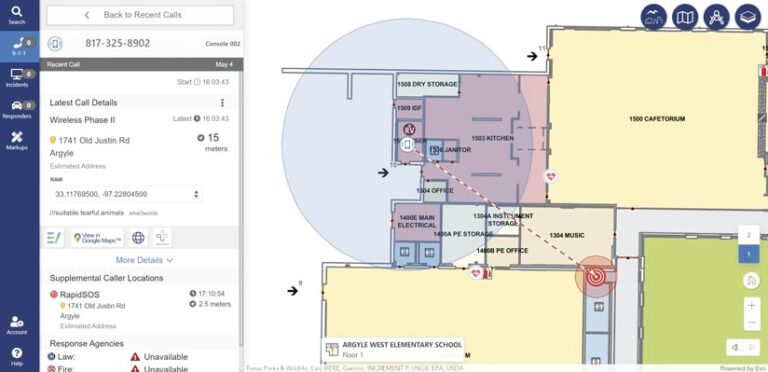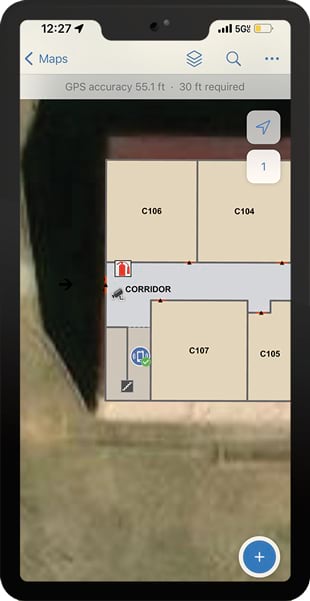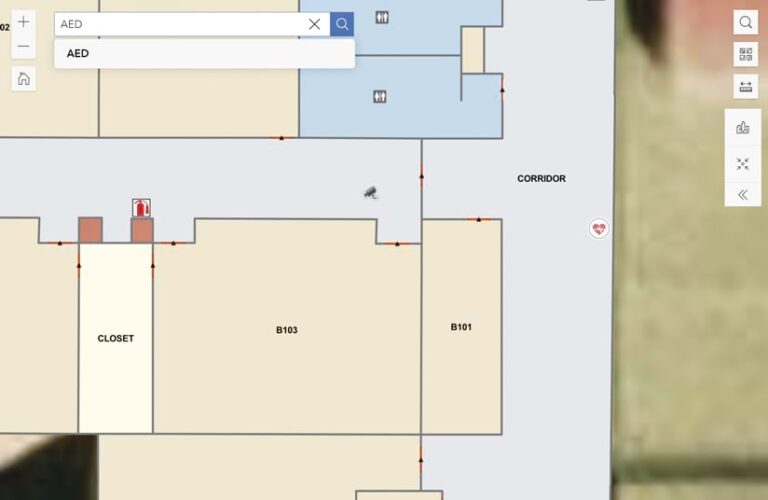When there is an emergency at a school—an earthquake, a child in need of medical assistance, or (unfortunately) an active shooter—it is imperative that first responders have a detailed map of the campus’s indoor and outdoor spaces. This helps streamline response efforts and reduces the time it takes to get to key locations.
However, not many schools provide these maps to local public safety organizations—if the schools have them at all. This is what motivated Gregory Ballentine, the executive director of the Denco Area 9-1-1 District in Denton County, Texas, to map all the schools in the region. It is plausible that a major event could occur on a school campus, according to Ballentine, so first responders need accurate location information for these facilities, especially since they tend to comprise very complex indoor and outdoor environments.

Denco 9-1-1, which serves roughly 800,000 people, recently collaborated with Esri partner GeoComm to put together detailed maps of 86 K–12 schools in the area. The emergency response organization is now looking to expand this effort to private schools and local businesses.
“The indoor maps are…a response tool during a crisis,” Ballentine said. “While the maps won’t prevent a tragic event, access to this enhanced data should assist in emergency response, thereby increasing the potential of saving lives.”
A New System for Safety
GeoComm specializes in developing public safety solutions for a range of clients. Its new GeoComm School Safety solution runs in customers’ own ArcGIS Online organizational accounts and incorporates a host of other Esri technologies.
The solution helps customers employ GeoComm services and software solutions to build GIS-based school maps that cover both the indoor and outdoor areas of a campus. The indoor maps conform to the ArcGIS Indoors Information Model and are created from a variety of inputs, including floor plan blueprints, 2D and 3D digital models generated with photogrammetry and lidar data, on-site surveys and measurements, and other maps.
Once the school maps are ready, they are published as hosted feature layers in customers’ ArcGIS Online organizational accounts. Customers include school districts; local public safety and emergency management agencies; and state-level departments of education, public safety, and homeland security.
The team at GeoComm can then configure a variety of Esri apps to support various use cases. A hub site, built with ArcGIS Hub, serves as an entry point for stakeholders into the system of engagement and collaboration.

A handful of public-facing pages within the hub site describe the objectives and benefits of having this system of engagement and detail current initiatives—such as collecting floor plans from all schools in the area or conducting school censuses—and their statuses. These pages also provide instructions for how other local schools and public safety agencies can join the community.
In addition, the hub site serves as a gateway for authorized users to access sensitive information, maps, and apps. A dashboard, developed using ArcGIS Dashboards, shows the status of the mapping initiative; census data for all the schools being mapped; and relevant events, metrics, and measurements. There are several end-user apps on the hub site as well that can be used to plan for and respond to emergencies in and around school campuses. A web app, configured using ArcGIS Experience Builder, serves as a tactical mapping app that school resource officers can use. And field personnel can employ ArcGIS Field Maps and ArcGIS Survey123 to collect data in near real time using their mobile devices. This data collection can happen during emergency planning—to determine reunification sites, for example—or during a live incident to enhance collaboration. The mapping apps employ web maps and web scenes to display indoor and outdoor maps in both 2D and 3D.
During an emergency, it is imperative for stakeholders to be able to share information quickly and securely. The maps and apps powered by ArcGIS Online support this kind of seamless collaboration. For example, GIS administrators at the local police department can enable location tracking within their ArcGIS Online organization to ensure that all officers who are dispatched to an emergency are sending location tracks back to the organization while using Survey123 or Field Maps.
The entire ArcGIS technology-based solution also enables schools to seamlessly share their campus maps with local public safety agencies and 9-1-1 call centers. GeoComm makes the school maps available to other existing 9-1-1 and emergency responder apps so that 9-1-1 operators, dispatchers, and other emergency personnel can use the maps when coordinating responses. GeoComm’s APIs also enable public safety agencies to share information—such as the near real-time locations of 9-1-1 callers and emergency responders—via the solution. This way, everyone involved in an emergency has a common operating picture, enabling faster, more efficient responses when every second counts.
Better Visualization of Complex Spaces
To make the school safety solution operable in Denco 9-1-1’s jurisdiction, Ballentine and his colleagues requested floor plans and other relevant information from each school. With help from the team at GeoComm, they then used these resources to create the digital maps. This was challenging, according to Ballentine and Denco 9-1-1 GIS manager Vanessa Green-Montgomery, because while some schools sent their floor plans right away, others took a long time to respond and had to be prodded. Another issue was that the quality of some of the floor plans was too poor to use to generate accurate maps of the facilities.
“With that particular challenge, we had to come up with a process,” said Green-Montgomery.

Denco 9-1-1 ended up purchasing equipment from Esri partner GeoSLAM to get 3D scans of the schools that had submitted low-quality floor plans. Nearly four years after the start of the project—with some major delays due to the COVID-19 pandemic—data collection was completed for all public schools in the Denco 9-1-1 response area by early 2023.
The maps, which consist of more than 220 school buildings, are now in use at emergency communication centers throughout the Denco 9-1-1 response area—including at the Flower Mound Police Department, where captain Jason Hawley works. He said that the detailed layers benefit first responders, whether they’re called in for an active shooter situation or another type of emergency.
The maps contain information such as the locations of fire extinguishers; security cameras; and automated external defibrillators (AEDs), which are used to quickly treat someone experiencing cardiac arrest. In addition to showing first responders where this equipment is, these landmarks can help callers identify the exact location of an emergency. This is a far cry from the PDF-based school maps that the Flower Mound Police Department worked with before. Those were often outdated and made it difficult to find specific locations.
“This technology is better,” said Hawley. “We can now visualize these maps in a cleaner manner that actually is suited to how it fits in our GIS.”
Now that 86 school maps are in Denco 9-1-1’s system, if an emergency call comes in from one of those schools, operators can use the floor plan and other details in the school’s indoor and outdoor maps to plot a precise location for where the call is coming from. The more information the caller gives, the more likely that the operator can plot the call down to the room.
“You would actually be able to see where the call is coming from,” said Green-Montgomery. “GIS plays an integral part in that.”

